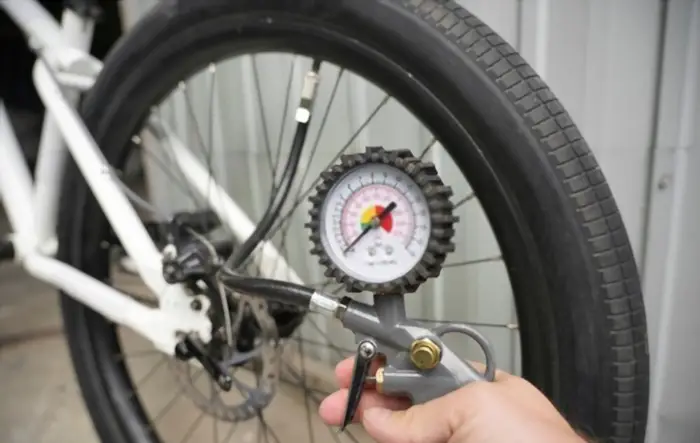Your bike’s pressure can affect how well it handles on the road. For this reason, tire pressure gauges are essential equipment to have at hand. They will help you know when the tire pressure is low and will also help you know when your tires are over-inflated.
One frequently asked question by bike enthusiasts is whether a car tire gauge can be used in place of a bike tire gauge. This article will compare the two tire gauges to help answer the question.
Bike Tire Gauge vs Car Tire Gauge
The bike tire gauge and the car tire gauge are all used for the same purpose: to check the tire pressure. The main difference between the two is their stem attachment.
For this reason, you might find it hard sometimes to use the gauges interchangeably.
However, this does not mean that you can not use a bike tire gauge on a car tire or a car tire gauge on a bike tire. If your bike has the Schrader valve found on car tires, you can use the car tire gauge to check the pressure on your bike tire. Also, in such a case, you can use your bike tire gauge to check the pressure on your car tires.
On the other hand, if your bike uses the Presta valve, you face challenges using a car tire gauge to measure its tire pressure. This is because the Presta valve is half the diameter of the Schrader. However, you can still buy an adaptor to help convert a Presta valve into a Schrader valve. But using your bike tire gauge on a car tire in such a case will be impossible.
Bike vs Car Tire Pressure
Compared to car tires, bike tires tend to have more pressure.
Since bicycle tires have less air than vehicle tires, even a slight deformation (flattening) brought on by the weight would “pinch” the tire against the rim and result in poor road holding, uncomfortable riding, and possibly a flat.
There is, however, more to it. A tiny portion of the ground is in touch with bicycle tires. Even though this is not what you wish to ensure road holding at high speeds, the reduced friction is helpful for energy efficiency. Energy efficiency is more significant than high-speed road-holding because bicycles are powered by human effort, which is limited, and because bikes cannot travel at very high speeds anyway.
Since the load on the tire is transferred to the road through a small surface, a small contact patch results in high ground pressure. If the ground pressure is high, the air pressure within the tire must also be high; otherwise, the tire will flatten, and the contact patch’s surface will rise until the two pressures—the patch on the ground and the air inside the tire—arrive at equilibrium. You will be standing on the rim if they don’t come into balance, which means that the pressure on the pavement patch is always larger than the pressure within the tire.
Therefore, the high air pressure inside the bike tire is required to achieve a tiny contact patch on the ground, reduce friction, and maximize energy efficiency. However, keep in mind different bike tire has different tire pressure such as 700c and 27 Inch bike tires have different tire pressure.
Below is a table comparing bikes tire pressure against car tire pressures:
| Bikes | Cars | Difference |
| Kid’s bike tires: 20 to 40 PSIRoad bike tire/narrow bike tires: 80 to 130 PSIHybrid bikes/medium size tire: 50 to 70 PSIMountain bikes: 30 PSI off-road and 50 PSI on-road | Passenger cars: 30 to 40 PSITrucks: 50 to 80 PSISports car: 30 to 40 PSI | The range difference in bike and car tire pressure is 20-80 PSI depending on the tires that you are comparing |
What to Look for When Buying a Tire Gauge?
Type of Valve
When purchasing a gauge, the type of valve is an essential factor to consider. Two different kinds of valves exist.
The first type is the Schrader valves seen on most lower-end bikes. The valves can also be seen on go-karts, lorries, and the tires of cars.
Second, are the smaller Presta valves that are exclusive to bikes. They are frequently found in more expensive versions.
Tire pressure gauges must be compatible with the right kind of valve, just as the pumps.
The good news is that it’s not the same problem it formerly was because modern gauges feature nozzle heads that function with both Schrader and Presta valves.
However, it is crucial to keep in mind that not all gauges are compatible with all types of valves, so be sure to double-check this.
If you discover that the pressure gauge you bought is incompatible with the type of valve you have, don’t worry; you may purchase an adaptor to make things work. The drawback is that they don’t always provide readings that are as precise as those offered by dedicated pressure gauges.

Digital or Analog Gauge
The display type can distinguish between digital and analog pressure gauges.
Digital displays are reputed to be simpler to read and frequently provide a more accurate reading. Your psi reading can be displayed to the nearest decimal point.
However, that doesn’t imply analog doesn’t have benefits—it definitely does! Since these gauges don’t need batteries, they are always reliable.
Digital pressure gauges are more likely to degrade over time since they contain more electronic components.
Both types have their advantages. Knowing your preferences and the drawbacks of each system is necessary.
Maximum PSI Reading
You must know the maximum psi/bar reading depending on how you want to utilize your pressure gauge.
You won’t need to worry too much about the maximum if you require a gauge for passenger car tires or mountain bike bicycle tires.
Road bikes rarely require their psi to rise above 100, especially if running tubeless. For example, both 25c and 28c tires requires less than 95 psi
Mountain bikes equipped with Schrader valves cannot exceed 100 psi, and most gauges can accept this.
However, you might require your pressure gauge to read over 200 psi on mountain bikes if you wish to measure the suspension.
Durability
If you want to take your pressure gauge on rides, durability is crucial.
The ideal model can withstand a few drops without experiencing any damage.
Some pressure gauges are made of industrial-grade materials, giving you the highest level of assurance regarding their longevity.
However, some offer the option of installing a rubber cover, depending on the model you select. You receive more protection as a result, free of charge.
Frequently Asked Questions (FAQ)
Can I Utilize Car Tire Gauge on My Bike?
You can use your car tire gauge on your bike, but you need to ensure that you have a suitable valve.
What Should You Do if the Tire Gauge You Bought Incompatible with the Valve You Have?
If your new tire gauge is incompatible with the valve on your tire, consider buying an adaptor. The adaptor will help make the valve compatible with your new tire gauge.
Which is the Most Accurate Tire Pressure Gauge?
The JACO ElitePro 100 PSI is the most accurate pressure gauge available in the market.
What PSI Should You Inflate Your Bike Tires?
If your bike utilizes the typical road tires, you can inflate it to around 80 to 130 PSI.
Conclusion
Hope this article helped you understand the differences between the bike tire gauge and the car tire gauges. There is not much difference, and the gauges can be used interchangeably. However, ensure you have the correct valve when using the gauges. If the valve is incompatible with the tire pressure gauge, you might need an adaptor.
